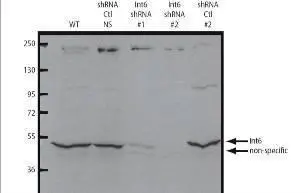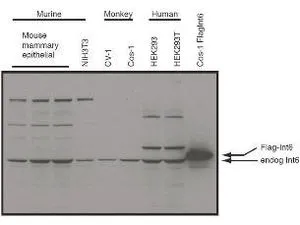
Western blot using GeneTexs affinity purified anti-eIF3S6/Int6 antibody shows detection of endogenous eIF3S6/Int6. Specific staining is not present in lysates containing lentiviral shRNA knockdown vectors
eIF3e antibody
GTX48712
ApplicationsWestern Blot, ELISA
Product group Antibodies
ReactivityHuman, Monkey, Mouse
TargetEif3e
Overview
- SupplierGeneTex
- Product NameeIF3e antibody - KO/KD Validated
- Delivery Days Customer9
- Application Supplier NoteWB: 1:1000. ELISA: 1:90000. *Optimal dilutions/concentrations should be determined by the researcher.Not tested in other applications.
- ApplicationsWestern Blot, ELISA
- CertificationResearch Use Only
- ClonalityPolyclonal
- Concentration0.8 mg/ml
- ConjugateUnconjugated
- Gene ID16341
- Target nameEif3e
- Target descriptioneukaryotic translation initiation factor 3, subunit E
- Target synonyms48kD; 48kDa; Eif3; eIF3e; eIF3-p; eIF3-p46; eIF3-p48; Eif3s6; eukaryotic translation initiation factor 3 subunit E; eukaryotic translation initiation factor 3, subunit 6 48kDa; In; Int6; mammary tumor integration site 6; mammary tumor-associated protein INT-6; MMTV integration site 6; viral integration site protein INT-6
- HostRabbit
- IsotypeIgG
- Protein IDP60229
- Protein NameEukaryotic translation initiation factor 3 subunit E
- Scientific DescriptionInt6 is a candidate tumor suppressor in multiple neoplasms, and in particular, breast and lung cancers. The Int6 locus was initially identified as a common insertion site (CIS) in a genetic screen for transforming sequences in a breast cancer mouse model system. Insertion of mouse mammary tumor virus (MMTV) into this locus results in the production of an amino-terminal truncated gene product. Expression of the truncated Int6 product corresponds to cellular transformation in both in vivo and in vitro systems. This gene product plays a role in regulating translation initiation and is a component of the eIF3 translation initiation complex.There is evidence that suggests that Int6 may impart a negative role in the general translational machinery while promoting an increase in the expression of a subset of stress-responsive genes. Taken together, it is of great interest to further study the mechanism by which Int6 is involved in regulating cell growth.
- ReactivityHuman, Monkey, Mouse
- Storage Instruction-20°C or -80°C,2°C to 8°C
- UNSPSC12352203

